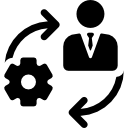Prototypes: Difference between revisions
Mr. MacKenty (talk | contribs) (Created page with "right|frame|System Fundamentals<ref>http://www.flaticon.com/</ref> Once you have understood and chosen a system, you must diagram how the system work...") |
Mr. MacKenty (talk | contribs) No edit summary |
||
| (36 intermediate revisions by 2 users not shown) | |||
| Line 1: | Line 1: | ||
[[file:system_fund.png|right|frame|System Fundamentals<ref>http://www.flaticon.com/</ref>]] | [[file:system_fund.png|right|frame|System Fundamentals<ref>http://www.flaticon.com/</ref>]] | ||
Prototypes are simplified versions of a system that are used to test and refine the requirements. They can be used to demonstrate the proposed system to the client in order to get feedback on the design and functionality of the system. | |||
There are several benefits to using prototypes to demonstrate the proposed system to the client: | |||
# Prototypes allow the client to see and interact with a rough version of the system, which can help them better understand how the system will work. | |||
# Prototypes allow the client to provide feedback on the design and functionality of the system, which can help the development team make necessary changes before the final version of the system is built. | |||
# Prototypes can help the client visualize the final product and understand how it will fit into their business or organization. | |||
# Prototypes can help reduce risk by allowing the client to identify and address any issues or concerns before the final version of the system is built. | |||
== Real-world practical advice == | == Real-world practical advice == | ||
There is almost always a gap between what the client wants and what the designer THINKS the client wants. Prototypes help narrow the gap efficiently. | |||
== Standards == | == Standards == | ||
These standards are used from the IB Computer Science Subject Guide<ref>IB Diploma Programme Computer science guide (first examinations 2014). Cardiff, Wales, United Kingdom: International Baccalaureate Organization. January 2012.</ref> | |||
* Describe the purpose of prototypes to demonstrate the proposed system to the client. | * Describe the purpose of prototypes to demonstrate the proposed system to the client. | ||
== References == | == References == | ||
Latest revision as of 10:24, 9 January 2023

System Fundamentals[1]
Prototypes are simplified versions of a system that are used to test and refine the requirements. They can be used to demonstrate the proposed system to the client in order to get feedback on the design and functionality of the system.
There are several benefits to using prototypes to demonstrate the proposed system to the client:
- Prototypes allow the client to see and interact with a rough version of the system, which can help them better understand how the system will work.
- Prototypes allow the client to provide feedback on the design and functionality of the system, which can help the development team make necessary changes before the final version of the system is built.
- Prototypes can help the client visualize the final product and understand how it will fit into their business or organization.
- Prototypes can help reduce risk by allowing the client to identify and address any issues or concerns before the final version of the system is built.
Real-world practical advice[edit]
There is almost always a gap between what the client wants and what the designer THINKS the client wants. Prototypes help narrow the gap efficiently.
Standards[edit]
These standards are used from the IB Computer Science Subject Guide[2]
- Describe the purpose of prototypes to demonstrate the proposed system to the client.
References[edit]
- ↑ http://www.flaticon.com/
- ↑ IB Diploma Programme Computer science guide (first examinations 2014). Cardiff, Wales, United Kingdom: International Baccalaureate Organization. January 2012.